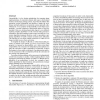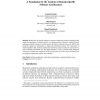311 search results - page 45 / 63 » DisCComp - A Formal Model for Distributed Concurrent Compone... |
PLDI
2012
ACM
11 years 9 months ago
2012
ACM
Linearizability is a key design methodology for reasoning about tations of concurrent abstract data types in both shared memory and message passing systems. It provides the illusi...
LICS
1996
IEEE
13 years 11 months ago
1996
IEEE
We present a formal model for concurrent systems. The model represents synchronous and asynchronous components in a uniform framework that supports compositional (assume-guarantee)...
JUCS
2008
13 years 7 months ago
2008
: Prediction of the quality attributes of software architectures requires technologies that enable the application of analytic theories to component models. However, available anal...
ICALP
1994
Springer
13 years 11 months ago
1994
Springer
When provingthe correctness of algorithmsin distributed systems, one generally considers safety conditions and liveness conditions. The Input Output I O automaton model and its ti...
UIST
1993
ACM
13 years 11 months ago
1993
ACM
Model-based user interface design is centered around a description of application objects and operations at a level of ion higher than that of code. A good model can be used to su...


